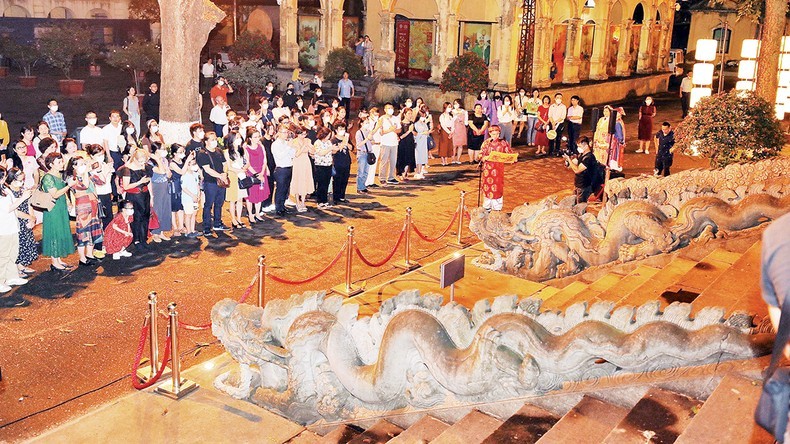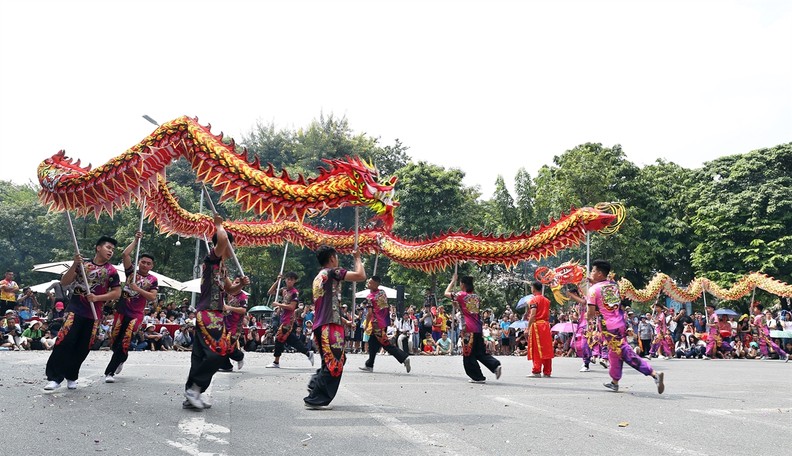A dragon is described visually with physical characteristics taken from nine different animals: the horns of a stag, the head of a camel, the eyes of a demon, the neck of a snake, the belly of a clam, the scales of a carp, the claws of an eagle, the soles of a tiger, and the ears of a cow. Although it is a mythical creature, dragons have been symbols in the life and culture of Asian people since ancient times.

Two stone dragons in front of Kinh Thien Palace in Thang Long Imperial Citadel in Ha Noi.
“Rong” is a Vietnamese word referring to dragon, but for a long time, Vietnamese people have assumed that “thin” and “long” are two common words referring to dragon.
Of these terms, “thin” is of Chinese origin, it indicates time, for example, the hour of “thin”, the year of “thin”. In the 12 Chinese zodiacs, “thin” symbolises the dragon.
“Long” is also a Chinese word with many meanings, but when it is used to name a person or a land, it has two meanings: dragon and prosperity.
The dragon symbolises strength and power. Thus, in royal culture, the word “dragon” is the symbol of kings.
For Vietnamese people, dragons are considered one of the most important cultural symbols as it is associated with the origins of the nation.
Vietnamese people identify themselves as descendants of the Dragon and of the Fairy, in which the Dragon is the symbol of the Yang, the Father, the mountain, and strength, whist the Fairy is the symbol of Yin, the Mother, the sea, and softness.
Dragons appear quite a lot in Buddhism with the meaning of protection, shielding, and service.
The altar in the main hall of many Buddhist temples in the northern regions, has the Cuu Long (Nine Dragons) Temple. The Cuu Long Court features an image of the new-born Lord Buddha, the finger of his right hand pointing to the sky, the other hand pointing to the earth. He is surrounded by nine dragons and clouds.
The images of images in various positions, such as ascending, lying, and gliding, are also carved on the roofs, walls, columns, and beams of pagodas.
Dragons not only appear in culture and are symbols of kings, but they also enter Vietnamese social life.
One of the first villages whose name was associated with a dragon was Long Do (dragon's navel) Village in Ha Noi. According to legend, the village is located at the mouth of the To Lich River. The village has a high mound, on top of the mound there is a vent, from here comes a puffing sound and people believe that it is the dragon's breath.
In the 5th century, Ly Bi (503-548) established the Van Xuan state and built a citadel in Long Do Village.
According to ‘Dai Viet Su Ky’ (Great Viet Historical Records), when King Ly Cong Uan (974-1028) relocated the capital from Hoa Lu to a new land, the boat parked temporarily at the foot of Dai La Citadel and he saw a dragon flying up, so he renamed the citadel as Thang Long (Ascending Dragon).
In 1802, Nguyen Anh (1762-1820) ascended the throne as King Gia Long and established the Nguyen Dynasty (1802-1945). King Gia Long moved the capital to Hue, and Thang Long was renamed Bac Thanh. He also changed the word “Thang Long” with the meaning of “ascending dragon” to “prosperity”.
In 1805, King Gia Long ordered the destruction of Thang Long citadel and built a new citadel. However, two stone dragons in front of Kinh Thien Palace remained. The pair of stone dragons still exist to this day.

Dragon dances always attract a large crowd both adults and children. (Photo: VIetnam Pictorial)
Today, the images of dragons are carved, sculpted, and cast in bronze in many places in Hue imperial city.
The Nguyen Dynasty monopolised the “Long” script, and this regulation was strictly maintained during the reigns of Nguyen Kings.
In 1831, King Minh Mang (1791-1841) carried out administrative reform. In 1932, he established Vinh Long Province, but the word “Long” of the name “Vinh Long” does not mean “dragon” but “eternal prosperity”.
Nine river branches flowing through the Southern region are called Cuu Long (Nine Dragons).
Although dragon is a sacred creature and is associated with the royals, it is also popular in the ordinary life.
The Mid-Autumn Festival, from urban areas to villages, is celebrated with dragon and lion dances, which attract a large crowd both adults and children. Wherever the dragon dance troupe goes, the people follow it until the dance concludes.
Dragons today are no longer symbols of power and the royals but it is an indispensable part in Vietnamese belief. Many people still choose the hour of the dragon to depart. Many couples want to have their children born in the year of the Dragon. Some automakers have launched limited editions with designs honouring the dragon. Also according to belief, the upcoming lunar year — the year of the Dragon — will be a good and successful year.